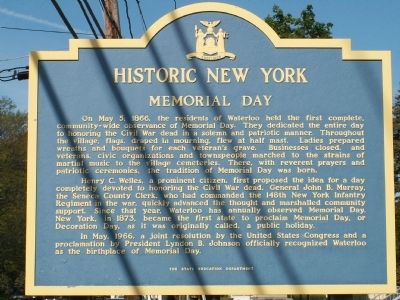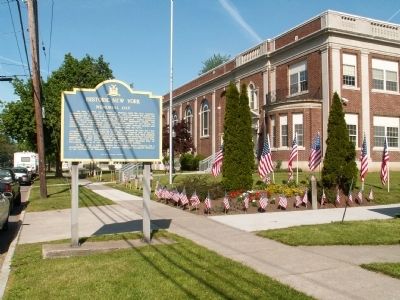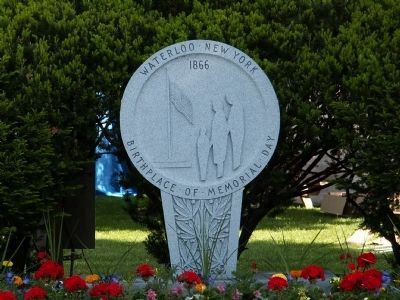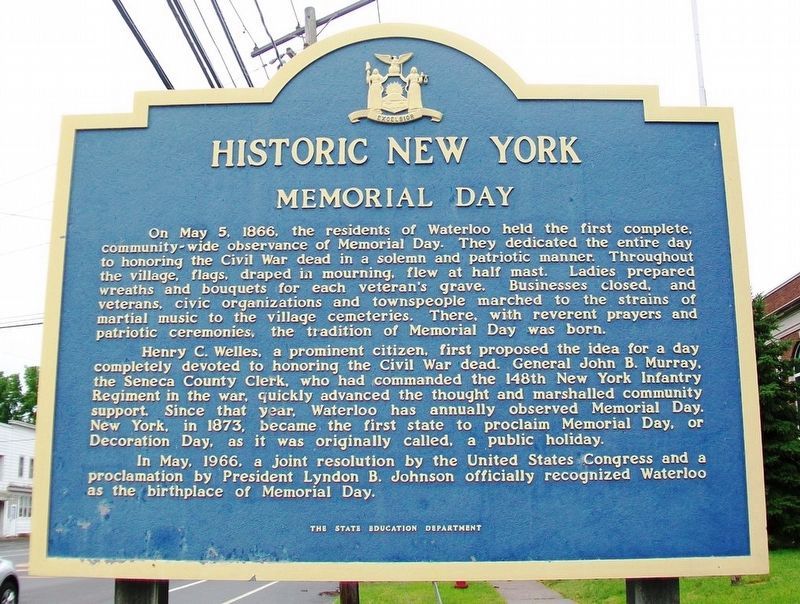Waterloo in Seneca County, New York — The American Northeast (Mid-Atlantic)
Memorial Day
Historic New York
Memorial Day
On May 5, 1866, the residents of Waterloo held the first complete, community-wide observance of Memorial Day. They dedicated the entire day to honoring the Civil War dead in a solemn and patriotic manner. Throughout the village, flags, draped in mourning, flew at half mast. Ladies prepared wreaths and bouquets for each veteran's grave. Businesses closed, and veterans, civil organizations and townspeople marched to the strains of martial music to the village cemeteries. There, with reverent prayers and patriotic ceremonies, the tradition of Memorial Day was born.
Henry C. Welles, a prominent citizen, first proposed the idea for a day completely devoted to honoring the Civil War dead. General John B. Murray, the Seneca County Clerk, who had commanded the 148th New York Infantry Regiment in the war, quickly advanced the thought and marshaled community support. Since that year, Waterloo has annually observed Memorial Day. New York, in 1873, became the first state to proclaim Memorial Day, or Decoration Day, as it was originally called, a public holiday.
In May 1966, a joint resolution by the United States Congress and a proclamation by President Lyndon B. Johnson officially recognized Waterloo as the birthplace of Memorial Day.
Erected by New York State Education Department.
Topics and series. This historical marker is listed in these topic lists: Notable Events • War, US Civil. In addition, it is included in the Historic New York State series list. A significant historical month for this entry is May 1779.
Location. 42° 54.268′ N, 76° 52.032′ W. Marker is in Waterloo, New York, in Seneca County. Marker is at the intersection of West Main Street (U.S. 20) and Park Place, on the right when traveling west on West Main Street. Touch for map. Marker is in this post office area: Waterloo NY 13165, United States of America. Touch for directions.
Other nearby markers. At least 8 other markers are within walking distance of this marker. General Sullivan’s New York Campaign Trail (within shouting distance of this marker); General Murray Residence (within shouting distance of this marker); Celebrating 100 Years of High School Education in Waterloo (within shouting distance of this marker); Korean Veterans Memorial (within shouting distance of this marker); Skoi-Yase (within shouting distance of this marker); Sampson Naval Training Station Veterans (within shouting distance of this marker); Lafayette’s Tour (within shouting distance of this marker); War Memorial (within shouting distance of this marker). Touch for a list and map of all markers in Waterloo.
Also see . . . The History and Origin of Memorial Day in Waterloo, New York. Waterloo website entry (Submitted on June 7, 2008, by Bryan Olson of Syracuse, New York.)
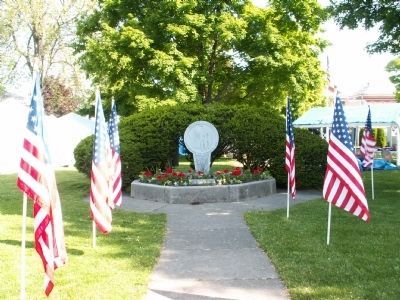
Photographed By Bryan Olson, May 24, 2008
3. The First Memorial Day Monument
This granite circular emblem, the official insignia of Memorial Day, was designed by art teacher Roger Meadway Jr. and erected in 1966 by the citizens of New York State when the village was officially recognized as the Birthplace of Memorial Day.
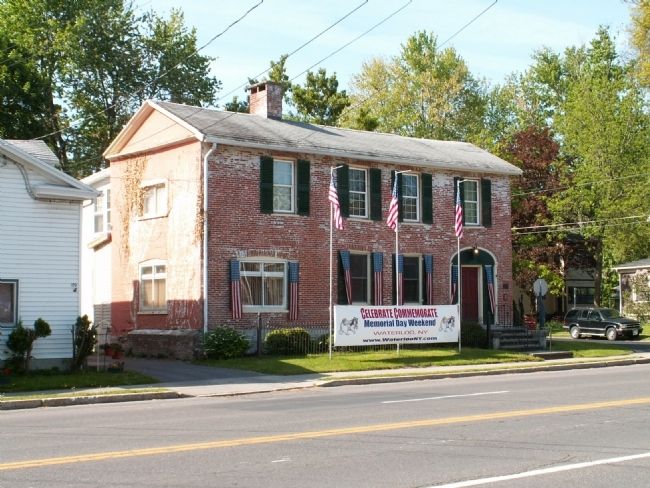
Photographed By Bryan Olson, May 24, 2008
5. Home of General Murray
The home of General Murray is located directly across the street from the First Memorial Day Marker. General John Murray was the power and influence behind Waterloo's first Memorial Day. A successful lawyer and politician, as colonel he commanded the 148th Regiment of NYS Volunteers in the Civil War, and later was promoted to brigadier general. He was elected Seneca County Clerk and lived in Waterloo until 1869.
Credits. This page was last revised on December 26, 2021. It was originally submitted on June 7, 2008, by Bryan Olson of Syracuse, New York. This page has been viewed 2,121 times since then and 39 times this year. It was the Marker of the Week May 30, 2010. Photos: 1, 2, 3, 4, 5. submitted on June 7, 2008, by Bryan Olson of Syracuse, New York. 6. submitted on June 25, 2017, by William Fischer, Jr. of Scranton, Pennsylvania. • Craig Swain was the editor who published this page.
